SPAIN
ISLAS CANARIAS
GRAN CANARIA
ISLAS CANARIAS
GRAN CANARIA
The Canary Islands, which belong to
Spain, are an archipelago of 7 major islands and the 6 smaller ones
situated about 115 km from the African coast in the Atlantic Ocean.
Gran Canaria is the third largest one
with a population of about 800.000 inhabitants. Its landscape is
volcanic, rich in contrasts and the weather is subtropical and very
pleasant.
The capital city of Las Palmas, in the north-eastern part of the island, is visited by many tourists and is bordered by beautiful beaches of golden sand.
Our high school is in La Isleta, one of the districts in Las Palmas de Gran Canaria.
The capital city of Las Palmas, in the north-eastern part of the island, is visited by many tourists and is bordered by beautiful beaches of golden sand.
Our high school is in La Isleta, one of the districts in Las Palmas de Gran Canaria.
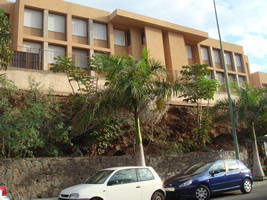
La Isleta is a mini-península separated from the rest of the Island by a narrow inlet, which is bordered on the south by the PORT OF THE LIGHT, one of the most important in Europe due to its geographical position. At present, about 1000 ships dock in the wharves.
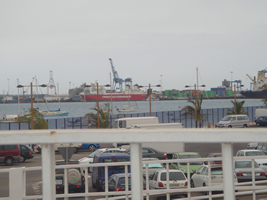
LOCATION
CANARY
ISLANDS
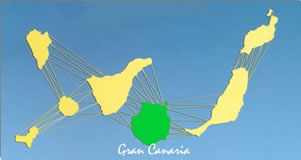
GRAN CANARIA
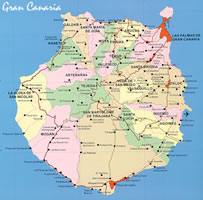
LA ISLETA
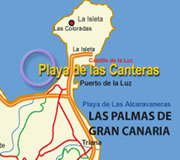
Opposite one of the wharves you can see THE CASTLE OF LIGHT, built in the 15th century, which served as a means of defence after the Spanish conquest.
Near this fortification there is a very important cosmopolitan park called SANTA CATALINA. It is full of palm trees and abundant vegetation. It is commercial and shopping center which dominates the center of Las Palmas, the Port and the coastal district.
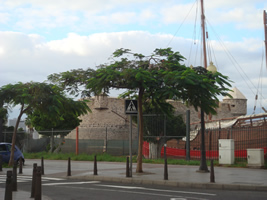
This
fishermen’s neighbourhood is characterised by its narrow streets, its
street sellers, its ancient shops, its bars and the naval base.
In the middle of the district, Manuel Becerra square is, with the lighthouse and the access to the Port surroundings.
From our high school you can see El Confital beach that is right next to Las Canteras beach, one of the most beautiful urban beaches in the country.
It is about 4 km long and has a parallel lava reef, called La Barra, which protects it from the ocean. Its promenade is full of restaurants, hotels, local shops and it is always crowded with people from all over the world.
On the north-western side of the beach, Alfredo Kraus auditorium is.
In the middle of the district, Manuel Becerra square is, with the lighthouse and the access to the Port surroundings.
From our high school you can see El Confital beach that is right next to Las Canteras beach, one of the most beautiful urban beaches in the country.
It is about 4 km long and has a parallel lava reef, called La Barra, which protects it from the ocean. Its promenade is full of restaurants, hotels, local shops and it is always crowded with people from all over the world.
On the north-western side of the beach, Alfredo Kraus auditorium is.
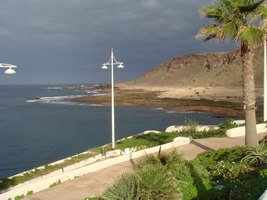
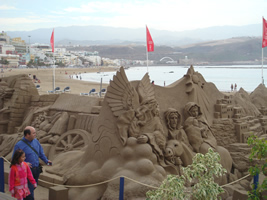
I.E.S NUEVA ISLETA - TONY GALLARDO
It is our high school, a 13-year-old
big building with 3 floors and a parking area. It has a football pitch
and a basketball court. There are two inner schoolyards with a garden
and an outer playground. It also has different classrooms, departments,
a library, a cafeteria, a teacher's room, a
gym, 3 laboratories, 3 computer classrooms and offices for the Principal
Vice Principal, the deputy head, the secretary and the psychologist.
There is a room for the parents who come to ask for the progress of
their children too.
Here
you can study Compulsory Education, Bachillerato, Formative Cycles and
Social Guarantee Programmes. It
has a very strict timetable: the lessons begin at 8:00 and finish at
2:00 in the afternoon with two breaks. And in the afternoon they start
at 3:00 until 8:30 with one break. There
are 49 teachers who are pleasant but they are sometimes serious and
angry. They teach many subjects such as Maths, Science, Art, English,
French, Latin, etc.
In November and December there is a small store in which students who study commerce sell things. We are 450 students. Some students are rebellious and badly-educated, but others are good and responsible..
There is a musical band with 3rd and 4th level students, called Ensemble Tony Gallardo.
In November and December there is a small store in which students who study commerce sell things. We are 450 students. Some students are rebellious and badly-educated, but others are good and responsible..
There is a musical band with 3rd and 4th level students, called Ensemble Tony Gallardo.

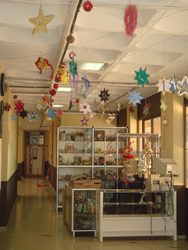
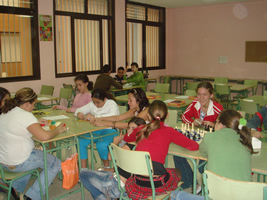
DID YOU KNOW THAT ...?
- The original inhabitants of the islands were The Guanches.
- The Canary Islands were initially dominated by Norman adventurers and Celtic immigrants from Portugal.
- The Dutchman Pieter Van Der Does captured, sacked and set fire to the city in 1599.
- Christopher Columbus stopped 3 times here on his voyages to the New World.
- Spanish conquered the islands in the 15th century.
- Between 17th and 19th century, many English people settled here, importing wine and cochineal from the canaries, and introducing the cultivation of the tomatoes and potatoes.
- Almost 96% of the inhabitants are Roman Catholic.
- The Canary islands have about 2000 different species of plants, out of which about 550 are endemic and about 600 are rare or under threat of extinction
- The economy is based on tourism, manufacturing and tropical agriculture (banana, tobacco, tomato,…).
- Canarian time is 1 hour less than that of Spain and the same as that of Britain and Portugal.